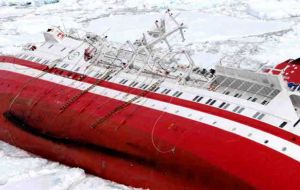MercoPress. South Atlantic News Agency
Doubts raised about sinking of Antarctic cruise M/S Explorer
 Speed and icerock could also be involved in the loss of the cruise vessel
Speed and icerock could also be involved in the loss of the cruise vessel More than two weeks after the ship M/S Explorer sank in Bransfield Strait off the coast of Antarctica, experts are questioning the official explanation of why the vessel sank.
Initial reports indicated that on Nov. 23 the S/M Explorer hit an iceberg located near the South Shetland Islands and the Antarctic peninsula called Graham Land. The vessel sank hours later and now lies on the ocean floor at a depth of some 4,921 feet (1,500 m). In spite the severity of the situation, no deaths or injuries were reported, and all of the passengers have since left the country. Up until now, it was widely believed the ship sank after it developed a fist-sized leak following an impact with an iceberg. But the position and size of the hole has led many to question this version of events and there are suspicions that there may have been more than one impact: several passengers reported they heard two bangs. Leif Skog, who served as the ship's captain for six years in the late 1980s and early 1990s, told ABC News that it was highly unlikely that pack-ice caused the ship to sink. He said that the sinking left him "totally shocked and surprised" because "she [the ship] was just outstanding in her design, perfect for ice-navigation." His comments were echoed by Jim Barnes, executive director of the Antarctic and Southern Ocean Coalition: "To think [the Explorer] could sink in less than 20 hours from a relatively modest incident is very surprising. It makes you wonder if something else happened, because it really doesn't add up." Furthermore, experts say that an iceberg large enough to cause serious damage would have been visible to the crew and would have shown up on the ship's sonar and radar systems. Doubts are reinforced by the fact that images of the stricken ship show her listing directly onto her starboard side. This suggests that she was holed mid-ship. But any damage resulting from an ice-impact would normally be found in the bow. Since the Explorer was built with a reinforced hull designed to withstand accidental ice impact, Skog and others speculate that it was not ice but rock that caused the damage. "There can be huge rocks frozen into the ice, and they can be hard to see," he said. Still, whatever the ship struck, it should not have sunk, according to Sander Calisal, professor emeritus of naval architecture at the University of British Colombia. The ship's watertight compartments should have contained the flooding if it were a case of just one leak. All these suspicions lead many to believe there was a second collision as the vessel drifted while engineers were working to contain the initial breach. This idea seems to be supported by several passengers who spoke of a loud bang while waiting at muster stations after the initial alarm was raised. An additional factor, according to an unnamed source in the Antarctic cruising industry cited by Chilean daily La Tercera, is that the ship may have been travelling too fast through the ice. GAP Adventures – the Toronto-based adventure tourism company that has operated the Explorer since 2004 – admitted that "We don't know exactly what happened." The ships insurer's Steamship Mutual is investigating. The Santiago Times




Top Comments
Disclaimer & comment rulesCommenting for this story is now closed.
If you have a Facebook account, become a fan and comment on our Facebook Page!